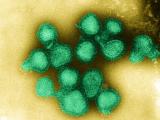Jul 13, 2011
Report shows rarity of IV antiviral use during 2009 pandemic
A letter report in today's Journal of the American Medical Association makes clear how rarely intravenous (IV) antiviral drugs were used during the 2009 H1N1 influenza pandemic. Two IV antivirals, zanamivir and peramivir, were made available under emergency investigational new drug and emergency use authorization rules. Researchers from the Centers for Disease Control and Prevention (CDC) gathered data on use of the drugs through the Emerging Infections Program, using a surveillance area including selected counties in 10 states and having a population of about 2.2 million. They identified 7,759 patients with confirmed 2009 H1N1 who were hospitalized between April 2009 and April 2010. Of 6,216 (80%) patients who received an antiviral, only 41, including 38 adults and 3 children, received an IV drug. Peramivir was used in 33 patients and zanamivir in 8. A shortage of data on effectiveness and safety in severely ill
patients and children may have discouraged use of the IV formulations, the report says. Death rates were 27% (11 of 41) in patients who received the IV drugs and 3% (174 of 6,175) in those treated with the licensed drugs. But the researchers say they could not assess the effectiveness of the medications, as those who received them tended to be more severely ill and obese, and no adequate comparison group was available.
Jul 13 JAMA letter report
Study: Children who shed novel H1N1 longer infect more people
Otherwise healthy children shed 2009 H1N1 pandemic flu viruses for up to 15 days after infection, and those who shed virus for at least 9 days were significantly more likely to infect household contacts, according to Italian researchers. In a study in Virology Journal today, the researchers reported taking nasopharyngeal swabs from 74 children at hospital admission and every 2 days until tests results were negative. All swabs were positive within 3 days of symptom onset, but only 21.6% were positive after 11 days, and 13.5% were positive after 15 days. No child produced a positive swab after more than 15 days of illness. Viral load also decreased with time. Those who shed viruses for 9 days or more were associated with significantly more cases of flu-like illness in their households within 2 weeks of symptom onset compared with briefer shedders (72.4% vs 42.4%), though longer shedding was not associated with more
cases of severe disease. The authors conclude that their study "could suggest that when a completely unknown influenza virus is circulating, [the] isolation period of infected children has to be longer than the 7 days recommended for the infections due to seasonal influenza viruses."
Jul 13 Virol J abstract
Misdiagnosis common in Scotland's first pandemic wave
A large analysis of respiratory samples that underwent full screening during the first 4 months of Scotland's 2009 H1N1 outbreak found that the clinical diagnosis for pandemic flu was wrong in most cases. Virologists from the West of Scotland Specialist Virology Center reported their findings today in BMC Infectious Diseases. Of 3,247 samples that received the full screening, respiratory pathogens were detected in 27.9%. Overall, the researchers found that 9% of tests in the patients, most of whom were clinically diagnosed as having pandemic flu, were positive for the 2009 H1N1 virus. However, patients were more likely to be infected with one of several other respiratory viruses. The most common ones were rhinovirus (8.9%), parainfluenza 3 (4.1%), adenovirus (3.5%), and parainfluenza 1 (1.9%). The authors said the findings highlight problems of using a clinical algorithm to detect the 2009 H1N1 virus when circulation levels
were low and that a large number of people were likely unnecessarily treated with oseltamivir (Tamiflu). They noted that a number of the samples could have been from the worried well or asymptomatic contacts of people with known or suspected 2009 H1N1 infections.
Jul 13 BMC Infect Dis abstract
Older people, men, minorities more likely to get H1N1 vaccine
A stronger intention to receive and higher actual uptake of pandemic 2009 H1N1 vaccine were associated with being older, male, and from an ethnic minority, according to a meta-analysis published yesterday in Vaccine. Researchers from England and the European Centre for Disease Prevention and Control conducted a systematic review of PubMed and Web of Science databases up to Jan 24, 2011, and found that 37 articles on H1N1 vaccine acceptance and uptake met their inclusion criteria. They identified social pressure as a factor: People were more likely to get vaccinated if they thought others wanted them to do so. They also found that official health sources also had a positive effect, as was past flu vaccination behavior. Among health professionals, physicians were most likely to get vaccinated. The researchers concluded, "Perceived concerns about vaccination can be tackled by reducing the omission bias (a perception
that harm caused by action is worse than harm caused by inaction). In addition, interventions to increase seasonal influenza vaccination in advance of a future pandemic may be an effective strategy."
Jul 12 Vaccine study




















